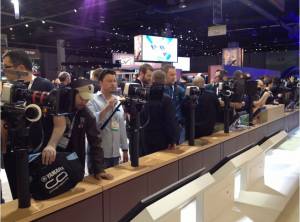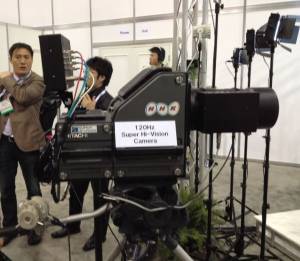The NAB hangover
Do you remember the 2009 cinema hit "The Hangover"? It was set in Las Vegas. All but one of the central characters was a seemingly intelligent professional, yet their Las Vegas experiences went far beyond what any rational person would do. No outrageous partying occurred among the people I associated with at NAB, but many of us found ourselves overindulging in information, demonstrations, novel ideas and walking.
Instead of nursing bad headaches like the actors in the movie, many of us who visited the 2013 NAB Show nursed aching feet and overstimulated brains. It was difficult not to be swamped with notes, literature, business cards and memories. Most attendees follow up by asking fellow visitors and reading Broadcast Engineering and newsletters for other takes on the show to discover what they missed. I think it’s safe to say everyone misses something important.
Some interesting facts about the show deserve mention. Slightly more than 26 percent of visitors were international and came from 155 countries. That percentage grows every year. There were 85,000 more square feet of exhibit space than last year. Also, I’m not sure what it means, but there were notably few visitors and exhibitors wearing neckties. I couldn’t help but notice, especially on the day I wore a tie.
It’s impossible for any one person to visit all 1600 exhibits in the 1920 minutes the exhibits are open. At best, other than shopping for specific items, the most a visitor can hope to take home is a clearer vision of the industry and the technology and trends that drive it. It’s also a terrific opportunity to network, visit with old friends and make new ones.
Who’s driving the bus?
Like new car models in October, the NAB show marks the beginning of a new broadcast technology year. The difference between this year’s NAB and previous NAB Shows was the users of new technology. This year, manufacturers appeared to agree that our technology-driven business is being driven more by consumer technology and consumer viewing habits than by broadcasters and new broadcast technologies.
The second screen seems to have graduated from last year’s next big thing to a given. Conversely, 3DTV was rare as a CRT display. I heard a rumor that one exhibitor was trying to sell a couple of used 3DTVs, but other than that, the technology was conspicuous by its absence.
My son asked me last winter about 3DTV. He wanted to buy a new big screen TV for a Super Bowl party he was planning and was looking at 3DTVs but didn’t want to purchase 20 or so pairs of 3-D glasses for his guests. Apparently, he wasn’t the only one who discovered the reality of 3DTV for home viewing just wasn’t practical.

The 3-D legacy
The good news about 3DTV is that its bandwidth legacy enables new technology that could be put to better use, such as 4K. While the jury is still out about 4K home viewing, 4K makes all kinds of sense in production and post. More about 4K later in this tutorial.
The most prevalent words and acronyms that echoed through the exhibit halls were UltraHD (UHDTV), 4K, 8K, HEVC and IP. New, more company-specific catch phrases peppered the show and revealed the big picture. Harmonic talked about “Time Shift TV.” Snell called it “Appointment TV.” ChyronHego’s phrase was “Augmented Reality.” Quantel focused on an “Internet of frames.” Harris Broadcast’s idea was “Any Device, Any Moment.” Manufacturers talked about “TV Anywhere” and “TV Everywhere.” Avid touted “Avid Everywhere.” Sony’s new company line was “Lens to Living Room.” All these new slogans and phrases collectively described changing habits in the video and television production, post and distribution workplace, and consumer viewing. People creating programming and controlling the technology are working from anywhere and viewers are watching from everywhere.
Many questions were being asked about the future of over-the-air broadcast television. It’s beyond the scope of this installment of "Transition to Digital" to discuss these questions in depth, but I heard more than one industry leader describe the amazement of younger people when they discover that TVs don’t necessarily need to be connected to a cable, and it’s free.
4KTV
The most prominent new technology being addressed nearly everywhere at NAB was 4K. The 4K vision had its beginnings at a company that was on few people’s radar in 2005, called RED. It was founded by Jim Jannard, who also founded Oakley Inc, maker of Oakley sunglasses. He sold Oakley in 2007, reportedly for more than $2 billion. That was, probably not coincidently, also the year the first RED One cameras were shown at NAB and delivered later that year.
In less than a decade, the 4K format has grown from zero and is headed to 8K and beyond. Nearly every manufacturer parenthetically mentioned 8K as the next natural step. If you are like me, you may question the viability of 4K for home viewing. At Sony, its full speed ahead as it recently introduced two 4K home TVs, a 65in version for $6999 and a 55in for $4999. They also introduced a 4K media player for $600, which includes 10 4K movies. That’s almost a bargain compared to the prices of plasma screens a decade ago.
There are two sides to the 4K story. One is that of home use, which remains to be seen. Is it the next HDTV or the next 3-D? On the production side, 4K i

s full of promise. It’s exciting and in many instances, it makes perfect sense.
Think of 4K as four HDTV screens, 2 x 2. Think of pan and zoom, where you can use the entire 4K area and convert it to HDTV, or use it to zoom in and move around on any one-fourth of the raster, still producing full-resolution HDTV. Now, think of a sports camera shot where the 4K camera wasn’t centered on the action, which happened to occur in the corner of the screen. The replay could pan and zoom to center the action on the HDTV feed.
As technology progresses, nearly everyone agrees 8K is virtually around the corner. Think of 8K as four 4K screens, 2 x 2. If 4K clicks with consumers and the format becomes common, the same effects can be accomplished in 8K as it is now with 4K and HDTV.
4K UHDTV has a resolution of 3840 x 2160, which is 8.3 megapixels. 8K UHDTV resolution is 7680 x 4320, equal to 33.2 megapixels. Standard 1920x1080 HDTV contains 2.1 megapixels. 8K is said to have the detail of 70mm IMAX film.
I happened to be watching the "House of Cards" series on Netflix the other day. The credits say the show was shot in RED 4K. The time lapse shots in the opening all are slowly panned and zoomed, clearly a 4K to HDTV effect. Impressive yet simple.
Was the 2013 NAB Show a success? The answer depends on you, me, our friends and our families. We’re all in control of the industry now.
Get the TV Tech Newsletter
The professional video industry's #1 source for news, trends and product and tech information. Sign up below.
